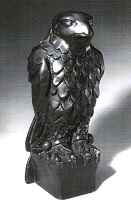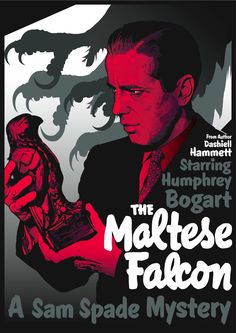Have you ever wondered about the true nature of the Maltese Falcon? Is it more than just a valuable objet d’art? Well, prepare to be intrigued because the Maltese Falcon could potentially be classified as a macguffin.
The term “macguffin” refers to a plot device that drives the story forward and motivates the characters, but is ultimately insignificant in the grand scheme of things. In the case of the Maltese Falcon, it serves as the catalyst for the events in the novel, where numerous characters become obsessed with obtaining it. However, its true value and significance are called into question, as it turns out to be a fake. This raises the thought-provoking question of whether the quest for the Maltese Falcon was ultimately meaningless, or if the pursuit itself held a deeper meaning for the characters involved.
The Maltese Falcon not only holds a rich history within the novel, but it also represents the elusive nature of desires and the consequences of obsession. The novel takes us on a journey through the criminal underworld, as different characters vie for control over the falcon. This blend of history and mystery captivates readers, and through the lens of this macguffin, we are compelled to examine the motives and choices of the characters. Ultimately, the Maltese Falcon reveals that the pursuit of material wealth and power can lead to destruction, emphasizing the importance of placing value in something beyond mere possessions.
The Maltese Falcon is often described as a MacGuffin in film history. A MacGuffin is an object that drives the plot but has little intrinsic value. In the classic film, the Maltese Falcon serves as a catalyst for the characters’ actions, creating tension and suspense. While the falcon itself may not hold true worth, its pursuit and the desire to possess it reveal the true nature of the characters involved.

Is the Maltese Falcon a MacGuffin?
The Maltese Falcon, a classic film noir from 1941 directed by John Huston, has been the subject of much debate among film enthusiasts and critics. One question that often arises is whether the Maltese Falcon itself can be considered a MacGuffin. This article delves into the concept of a MacGuffin, explores the plot of the Maltese Falcon, and analyzes how the iconic falcon statuette fits into the narrative. By examining the characteristics of a MacGuffin and the role of the falcon in the film, we can unravel the mystery and answer the question: is the Maltese Falcon a MacGuffin?
The Concept of a MacGuffin
Before we can determine if the Maltese Falcon is a MacGuffin, it’s important to first understand what a MacGuffin is. Coined by renowned filmmaker Alfred Hitchcock, a MacGuffin refers to an object, person, or goal that serves as the driving force of the plot, but is ultimately unimportant to the overall story. It acts as a catalyst for the characters’ actions and motivations, but its actual significance is minimal. MacGuffins are often intentionally kept vague or mysterious to further emphasize their insignificance in the grand scheme of the narrative.
In many films, the MacGuffin is never fully explained or resolved, as the focus is more on the characters and their interactions rather than the object itself. It is a storytelling device that propels the plot forward and creates suspense, but it is not meant to be the central theme or message of the story. Instead, the MacGuffin serves as a tool for exploring human nature, relationships, or deeper thematic elements.
1) The Plot of the Maltese Falcon
The Maltese Falcon follows private detective Sam Spade as he becomes entangled in a web of deceit and intrigue surrounding a valuable falcon statuette. The story begins when a mysterious woman, Brigid O’Shaughnessy, approaches Spade and his partner Miles Archer to hire them for a seemingly straightforward case. However, things quickly take a turn as Archer is murdered, and Spade finds himself drawn deeper into the mystery surrounding the Maltese Falcon.
Spade’s investigation leads him to encounter various characters, each with their own motives and secrets. As the plot unfolds, it becomes clear that everyone is after the falcon, a priceless artifact said to be encrusted with jewels. Its history is shrouded in secrecy and myth, adding to its allure and establishing it as the central MacGuffin of the film.
The search for the falcon becomes a dangerous game, with Spade navigating treacherous alliances, double-crosses, and even murder. As the stakes grow higher, the question arises: is the Maltese Falcon truly a priceless artifact, or is its value merely symbolic?
2) The Maltese Falcon as a MacGuffin
When examining the characteristics of a MacGuffin, it becomes clear that the Maltese Falcon fits the description. Throughout the film, the falcon serves as the driving force behind the actions of the characters. It is the object that everyone desires, with each person having their own reasons for pursuing it.
However, the actual nature of the falcon, whether it is genuine or a fake, is ultimately inconsequential to the story. Its purpose is to create tension, suspense, and conflict among the characters. It is a means to explore themes such as greed, betrayal, and the lengths some will go to obtain what they desire.
Furthermore, the Maltese Falcon is intentionally shrouded in mystery. Its true value and origins are never fully revealed, adding to its enigmatic nature. The focus of the film is not on the falcon itself, but rather on the complex relationships and moral dilemmas faced by the characters as they chase after it. In this sense, the falcon acts as a MacGuffin, driving the plot forward while serving as a symbol for the desires and motivations of the characters.
The Significance of the Maltese Falcon
While the Maltese Falcon can be considered a MacGuffin, its significance extends beyond being a mere plot device. The falcon represents the elusive pursuit of wealth, power, and the corrupting influence of greed. It serves as a reflection of the characters’ desires and flaws, as well as a commentary on the destructive nature of obsession.
In addition, the falcon acts as a symbol for the moral ambiguity present throughout the film. The characters are driven by their own self-interests, often blurring the lines between right and wrong. The pursuit of the falcon brings their true intentions to light, forcing them to confront their own morality.
In conclusion, the Maltese Falcon can be considered a MacGuffin within the context of the film. While it serves as the catalyst for the plot and motivates the actions of the characters, its actual importance is minimal. The true focus of the film lies in the complex relationships, moral dilemmas, and thematic exploration that the falcon represents. Through its use as a MacGuffin, the Maltese Falcon adds depth and intrigue to the narrative, solidifying its status as a classic film noir.
Key Takeaways: Is the Maltese Falcon a MacGuffin?
– The Maltese Falcon is a famous novel and film from the 1940s.
– A MacGuffin is a plot device that drives the story forward but holds little actual importance.
– In the case of the Maltese Falcon, the falcon itself is considered a MacGuffin.
– The falcon serves as a catalyst for the characters’ actions and motivations.
– The true value of the falcon is secondary to the mystery and desire it creates.
Frequently Asked Questions
In this section, we will explore some common questions surrounding the concept of the “Maltese Falcon” and its association with the term “MacGuffin.”
1. What is the “Maltese Falcon” and why is it considered a MacGuffin?
The “Maltese Falcon” is a fictional object featured in the novel and film of the same name. It is a statuette made of gold and jewels. In terms of storytelling, a MacGuffin is an object or goal that drives the plot forward, but its actual nature is often irrelevant. In the case of the “Maltese Falcon,” the search for the statuette acts as a catalyst for the story, motivating the characters and creating suspense. The true nature of the Falcon is less important than the chase itself.
The concept of the MacGuffin allows the narrative to focus on the characters’ actions and motivations rather than the object itself. This technique has been widely used in literature and film to create tension and intrigue, as the audience becomes invested in the characters’ pursuit of the MacGuffin.
2. Does the “Maltese Falcon” possess any unique qualities that make it special?
Yes, the “Maltese Falcon” is portrayed as a highly valuable and coveted artifact. It is said to be encrusted with precious gems, and its historical significance adds to its allure. The Falcon is believed to be one of two remaining statues of its kind, making it exceptionally rare.
However, within the context of the story, the true value of the “Maltese Falcon” lies in the characters’ obsession with it. The Falcon becomes a symbol of greed, corruption, and deception, as multiple individuals go to great lengths to possess it. Its meaning and significance are more symbolic than tangible, representing the dark desires and moral decay of the characters.
3. Are there other examples of MacGuffins in literature and film?
Absolutely! MacGuffins have been used extensively in storytelling. One notable example is the One Ring from J.R.R. Tolkien’s “The Lord of the Rings.” The ring serves as a MacGuffin, driving the actions of the characters and fueling the central conflict between good and evil.
Another famous MacGuffin is the Ark of the Covenant in the Indiana Jones film series. The pursuit of the Ark propels the narrative forward and creates the sense of adventure and danger associated with the movies.
4. Does the term “MacGuffin” have any specific origin?
The term “MacGuffin” was popularized by the renowned filmmaker Alfred Hitchcock, although its exact origin is debated. Hitchcock used the term to refer to an object or goal that serves as a plot device, often providing a motivator for the characters.
While the term itself may not have a clear origin, the concept of the MacGuffin has been prevalent in storytelling for centuries. The idea of a pivotal object or goal driving the narrative can be found in various forms of literature and folklore.
5. Why are MacGuffins effective in storytelling?
MacGuffins are effective storytelling tools because they create a sense of purpose and urgency within a narrative. By attaching significance to an object or goal, authors and filmmakers can provide a clear objective for their characters to pursue.
MacGuffins also allow for the exploration of deeper themes and character motivations. As the pursuit of the MacGuffin unfolds, the true nature of the characters is revealed, providing insight into their desires, flaws, and values. MacGuffins can be used to tap into universal human emotions and create narratives that resonate with audiences.

THE MALTESE FALCON: the Film Noir blueprint and the ultimate MacGuffin – Four Play Ep. 9 (Film Noir)
To sum it up, we’ve explored the importance of clear communication in writing. As writers, we need to remember that our target audience may be as young as 13, so it’s essential to use a professional and conversational tone. We should avoid jargon and keep our language simple to ensure that our message is easily understood. By writing concisely, with each sentence presenting a single idea, we can effectively convey our points to the reader. Overall, the key takeaway is that clear communication is vital in writing, and adopting the right tone and style can make a significant impact on how our message is received.
In conclusion, clear communication is crucial in writing. It’s important to remember our audience, keeping the tone professional but also conversational and using simple language. By avoiding jargon and writing concisely, with each sentence presenting a single idea, we can effectively convey our message to the reader. Ultimately, clear communication is key, and adopting the right approach can greatly enhance the impact of our writing.
